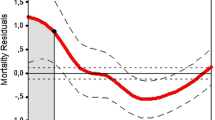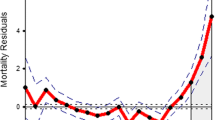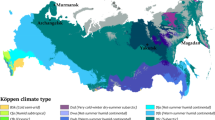Abstract
The study examines the relationship between sudden changes in weather conditions in summer, represented by (1) sudden air temperature changes, (2) sudden atmospheric pressure changes, and (3) passages of strong atmospheric fronts; and variations in daily mortality in the population of the Czech Republic. The events are selected from data covering 1986–2005 and compared with the database of daily excess all-cause mortality for the whole population and persons aged 70 years and above. Relative deviations of mortality, i.e., ratios of the excess mortality to the expected number of deaths, were averaged over the selected events for days D−2 (2 days before a change) up to D+7 (7 days after), and their statistical significance was tested by means of the Monte Carlo method. We find that the periods around weather changes are associated with pronounced patterns in mortality: a significant increase in mortality is found after large temperature increases and on days of large pressure drops; a decrease in mortality (partly due to a harvesting effect) occurs after large temperature drops, pressure increases, and passages of strong cold fronts. The relationship to variations in excess mortality is better expressed for sudden air temperature/pressure changes than for passages of atmospheric fronts. The mortality effects are usually more pronounced in the age group 70 years and above. The impacts associated with large negative changes of pressure are statistically independent of the effects of temperature; the corresponding dummy variable is found to be a significant predictor in the ARIMA model for relative deviations of mortality. This suggests that sudden weather changes should be tested also in time series models for predicting excess mortality as they may enhance their performance.








Similar content being viewed by others
References
Ballester F, Corella D, Perez-Hoyos S, Saez M, Hervas A (1997) Mortality as a function of temperature. A study in Valencia, Spain, 1991–1993. Int J Epidemiol 26:551–561
Bluestein HB (1993) Observational aspects of front. In: Synoptic-dynamic meteorology in midlatitudes: observations and theory of weather systems, vol. 2. Oxford University Press, New York, pp 255–297
Box GEP, Jenkins GM (1970) Time-series analysis: forecasting and control. Holden Day, San Francisco
Ebi KL, Exuzides KA, Lau E, Kelsh M, Barnston A (2004) Weather changes associated with hospitalizations for cardiovascular diseases and stroke in California, 1983–1998. Int J Biometeorol 49:48–58
Gosling SN, Lowe JA, McGregor GR, Pelling M, Malamud BD (2009) Associations between elevated atmospheric temperature and human mortality: a critical review of the literature. Clim Change 92:299–341
Hong YC, Rha JH, Lee JT, Ha EH, Kwon HJ (2003) Ischemic stroke associated with decrease in temperature. Epidemiology 14:473–478
Huynen MMTE, Martens P, Schram D, Weijenberg MP, Kunst AE (2001) The impact of heat waves and cold spells on mortality rates in the Dutch population. Environ Health Perspect 119:463–470
Kassomenos AP, Gryparis A, Katsouyanni K (2007) On the association between daily mortality and air mass types in Athens, Greece during winter and summer. Int J Biometeorol 51:315–322
Kašpar M, Müller M (2007) Diagnostic analyses of convective events—the effect of propagating gust fronts. Atmos Res 83:140–151
Kriszbacher I, Czopf L, Bódis J (2007) The effects of seasonal variations and weather conditions on the occurrence of heart attacks in Hungary between 2000–2004. Orv Hetil 148:731–736
Květoň V (1991) Weather fronts and acute myocardial infarction. Int J Biometeorol 35:10–17
Kynčl J, Procházka B, Goddard NL, Havlíčková M, Částková J, Otavová M, Kříž B (2005) A study of excess mortality during influenza epidemics in the Czech Republic, 1982–2000. Eur J Epidemiol 20:365–371
Kyobutungi C, Grau A, Stieglbauer G, Becher H (2005) Absolute temperature changes and stroke risk: a case-crossover study. Eur J Epidemiol 20:693–698
Kyselý J (2004) Mortality and displaced mortality during heat waves in the Czech Republic. Int J Biometeorol 49:91–97
Kyselý J, Kříž B (2008) Decreased impacts of the 2003 heat waves on mortality in the Czech Republic: an improved response? Int J Biometeorol 52:733–45
Kyselý J, Pokorná L, Kynčl J, Kříž B (2009) Excess cardiovascular mortality associated with cold spells in the Czech Republic. BMC Public Health 9:19
Le Tertre A, Legrand A, Einstein D et al (2006) Impacts of the 2003 heatwave on all-cause mortality in 9 French cities. Epidemiology 17:75–79
Ljung GM, Box GEP (1978) On a measure of a lack of fit in time series models. Biometrika 65:297–303
McGregor GR (1999) Winter ischaemic heart disease deaths in Birmingham, United Kingdom: a synoptic climatological analysis. Clim Res 13:17–31
McQuarrie ADR, Tsai C-L (1998) Regression and time series model selection. World Scientific, Singapore
Morabito M, Crisci A, Orlandini S, Maracchi G, Gensini GF, Modesti PA (2008) A synoptic approach to weather conditions discloses a relationship with ambulatory blood pressure in hypertensives. Am J Hypertens 21:748–52
Pirard P, Vandentorren S, Pascal M, Laadi K et al (2005) Summary of the mortality impact assessment of the 2003 heat wave in France. Euro Surveil 10:153–156
Plavcová E, Kyselý J (2009) Impacts of sudden air temperature and pressure changes on mortality in the Czech Republic (in Czech, with English summary). Epidemiol Mikrobiol Imunol 58:73–83
Revich B, Shaposhnikov D (2008) Temperature-induced excess mortality in Moscow, Russia. Int J Biometeorol 52:367–374
Schneider A, Schuh A, Maetzel F, Rückerl R, Breitner S, Peters A (2008) Weather-induced ischemia and arrhythmia in patients undergoing cardiac rehabilitation: another difference between men and women. Int J Biometeorol 52:535–547
Smoyer KE, Rainham DGC, Hewko JN (2000) Heat-stress-related mortality in five cities in Southern Ontario: 1980–1996. Int J Biometeorol 44:190–197
Whitman S, Good G, Donoghue ER, Benbow N et al (1997) Mortality in Chicago attributed to the July 1995 heat wave. Am J Pub Health 87:1515–1518
Acknowledgements
Thanks are due to the staff of the National Institute of Public Health, the Institute of Health Information and Statistics, and the Czech Hydrometeorological Institute for providing mortality and meteorological data. We acknowledge support from the Czech Science Foundation under project 205/07/1254.
Author information
Authors and Affiliations
Corresponding author
Rights and permissions
About this article
Cite this article
Plavcová, E., Kyselý, J. Relationships between sudden weather changes in summer and mortality in the Czech Republic, 1986–2005. Int J Biometeorol 54, 539–551 (2010). https://doi.org/10.1007/s00484-010-0303-7
Received:
Revised:
Accepted:
Published:
Issue Date:
DOI: https://doi.org/10.1007/s00484-010-0303-7




